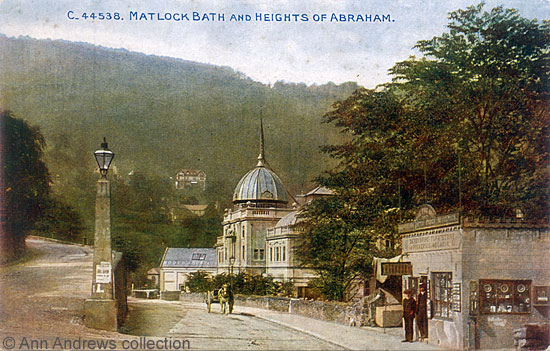|
Images Index> Matlock Bath, 20th and 21stC Images> This page |
| Matlock Bath: Grand Pavilion, Obelisk & Spar Shop |
| Matlock Bath : Twentieth Century Photographs, Postcards, Engravings & Etchings |
|
|||
The road to the left led to the Royal Hotel (originally the Old Bath and behind the wall centre left) and then on to Temple Walk and the Temple Hotel. The Temple is the building immediately above Boden's restaurant, which is the building with white lettering on the roof. Mrs. Cumming's early 1840's advertisement for her Old Bath Hotel provides an early view of the obelisk; it appears to be part of the hotel's drive. It was also mentioned in other nineteenth century guides, including as a means of navigating to a spar shop or petrifying well[2]. The earliest specific mention of a shop near the obelisk is found in the 1838 edition of Henricus's guide: "Mr. Joseph Pearson, has a shop near the Obelisk"[3]. When the Dowager Queen Adelaide, widow of King William IV, visited Matlock Bath in 1840 she stayed at the Old Bath. To welcome her triumphal arches of flowers were erected in several places, including "by the obelisk, leading up to the Old Bath"[4]. The hotel's name was painted on the obelisk for many years. An example is shown on a 19th century stereoview (linked right) when the words "ROYAL HOTEL, OLD BATH" were written on it. Photographic evidence shows that by the 1920s the obelisk had been repainted - the words Royal Hotel were sideways on down the length of the stone and beneath them were the words "To the Royal Hotel" (all in capitals) with the index finger on a hand pointing to the hotel so visitors would make no mistake! In the later 1920s the obelisk, still with the street lamp on top but without a bulb to light the way, was even clearer. "ROYAL HOTEL" was in large letters, each letter with studs on it, running vertically down the length of shaft. It also had a pointed arrow do denote where to go. A second, small, sign was attached to the bottom of the lamp with the words "LOWER ROAD BUXTON SHEFFIELD MANCHESTER" to avoid confusion although there was no helpful arrow on that sign[5]. It was re-painted in 1938 on the instruction of Mr. Moyes of the Temple Hotel, though on this occasion it bore the name of that hotel as the Royal Hotel had been burnt down and it had become clear it would not be rebuilt. The hotel's demolition and the sale of the site had made the situation abundantly clear. The web mistress's late father and his workmen painted, re-lettered and varnished the obelisk "sign" with the words TEMPLE HOTEL. Amazingly, the original estimate and invoice plus receipt still survive[6]. The small Spar shop on the right of the picture advertised Derbyshire Tufa Stone, Rockeries, Aquaria &c on the sign across the front, above the windows and door and there are pieces of stone to the left of the building. The name sign above the door is not readable and the sign across the top of the building is only partially so (it says "Fine Art"). There is a small white dog with black ears tied up against the wall close to the spar shop, presumably the shop proprietor's. In 1911 the "Lock up Shop", part of the Derwent Gardens, was being run by Mr Badger of Masson Road. He was a shopkeeper selling Fancy Goods[7] although there is more than Fancy Goods on sale here. The photographer Mr. Henshall also has a Lock up shop in the Derwent Gardens, probably in part of the same building, and he was later well known for the rockeries he designed which almost certainly explains the two signs. This small building can be seen on a number of 19th century images, including the one of the view from the Heights (linked on the right). It was demolished in 1921 and replaced by hard tennis courts[8]. Unfortunately, a former rubbish tip and a lead mine - the Providence Mine - on the adjacent land were covered over and in 1929 part of the court fell in, with disastrous consequences fot the Pavilion's first caretaker[9]. |
|||
|
"Matlock Bath and Heights of Abraham". One of the Celesque Series produced by the Photochrom Co. Ltd., London & Tunbridge Wells. C.44538. Unused, but another card was posted in 1912. Postcard in the collection of, provided by and © Ann Andrews who also researched the information. Intended for personal use only. |
|||
[1] Adam mentions an obelisk here in the first edition of his book "The Gem of the Peak" in 1838. He writes of it again in the second edition: Adam, W. (1840) "The Gem of the Peak" London; Longman & Co., Paternoster Row (p.30) that is on this website. [2] See: [3] Henricus (1838) "The Matlock Tourist; and Guide Through the Peak ...". It was later run by the Ogden family (see The Ferry House, Spar Shop & Obelisk, 19thC). [4] "Derby Mercury", 5 August 1840. Her Majesty the Queen Dowager. [5] Information from images, largely postcards, in private collections. [6] Ledger of estimates, invoices and receipts for Mr. Clay's painting and decorating business, 1938. Ann Andrews collection. [7] Information from the 1911 census and Kelly's 1912 Directory. He was on North Parade by the time of Kelly's 1916 Directory. [8] "Derbyshire Times", 17 Sept 1921. "The extraordinary success and popularity of the hard courts constructed at Matlock Bath this summer" [9] There is more about this and the man who lost his life on Matlock
Bath: Fish Pond Stables, Providence Mine & the Mud Heap and The Grand Pavilion (Kursaal), 1910-12,
Matlock Bath |

















